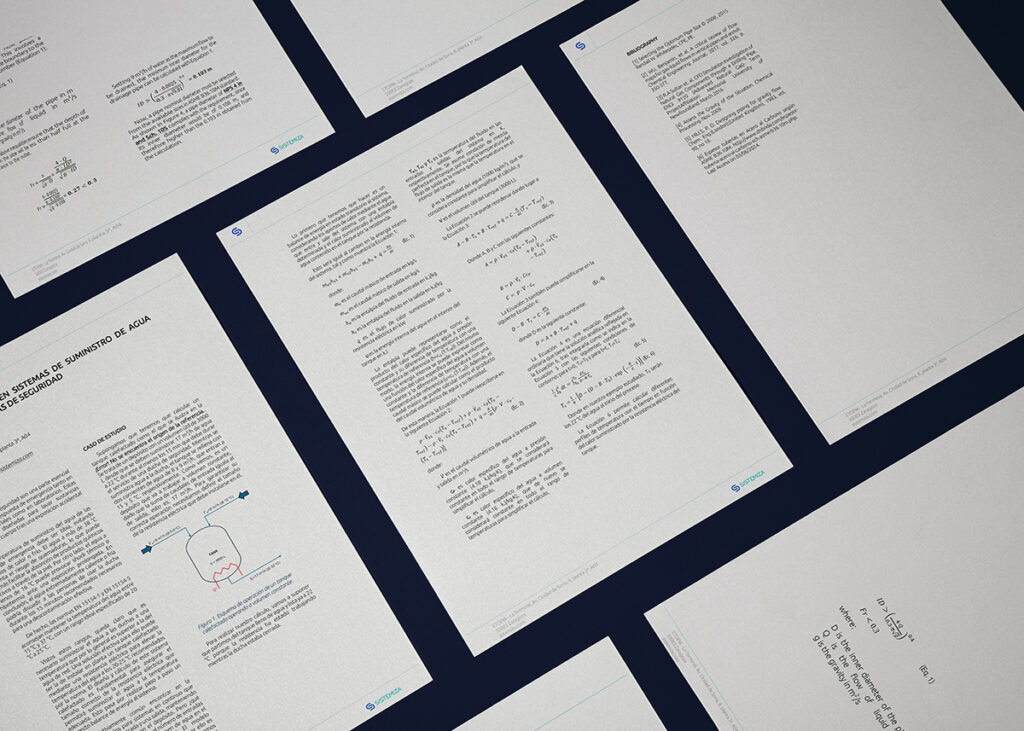Safety showers are a critical element in protecting workers in industrial environments and laboratories. However, its effectiveness depends not only on its availability, but also on the water supplied having the right temperature to prevent further damage to the skin and body.
According to the EN 15154 standard, the water in these showers should be kept in a range of 15-37°C, with an ideal of 20-25°C. Lower temperatures can cause thermal shock, while higher temperatures increase the absorption of chemicals into the skin.
At Sistemiza, we have developed an energy balance model that allows heating systems to be efficiently sized to ensure a stable supply of hot water in emergency showers. In this article, we explain the main challenges and solutions to optimize these systems.
Challenges in the supply of hot water in emergency showers
The design of a hot water supply system for safety showers faces several challenges:
Maintain the appropriate temperature for the minimum 15 minutes of use.
Avoid thermal fluctuations that may compromise the safety of the user.
Optimize energy consumption to reduce operating costs without impacting system reliability.
In many cases, the most efficient solution is the use of a heated tank with electric resistors, but its design must be precise to avoid energy waste or supply failures.
How to ensure a stable supply: The energy balance
To maintain thermal balance in a hot water tank, the following aspects must be considered:
1) Inlet and outlet flow rate
The cold water entering the tank must be balanced with the hot water that is extracted, ensuring a stable temperature.
2) Inlet Temperatures
Mains water usually enters cold (between 5 and 15°C), which forces the calculation of the energy needed to bring it to the optimal temperature.
3) Operation time
The system must guarantee a continuous supply for at least 15 minutes, the recommended time for effective decontamination.
4) Tank volume
A well-sized tank prevents sudden drops in temperature and allows efficient operation without overloading the electrical resistance.
5) Resistance power
The electrical resistance must be powerful enough to compensate for heat loss and keep the water within the ideal range.
Practical example: Calculating an optimal system
Let’s assume that we have a 3000 L tank that supplies 17 m³/h of water at 22°C, while being filled with two streams of water at 15°C and 5°C.
When evaluating different electrical resistor powers, we find the following:
150 kW: Not enough, the temperature drops below 20°C.
200 kW: Close, but there are still thermal fluctuations.
250 kW: Optimal, maintains 22°C stably.
300 kW: Excessive, increases temperature uncontrollably.
Conclusion: For this case, a 250 kW resistor is the most efficient option.
Comparison with other heating systems
In addition to the use of electric heating elements, there are other heating options:
Heat exchangers: They take advantage of external thermal sources (steam or hot water) to heat the water in the tank. More efficient, but require additional infrastructure.
Instant heaters: They raise the temperature of the water at the time of use. They can generate problems with flow and thermal stability if they are not well dimensioned.
Preheated tanks: They allow the storage of previously heated hot water, reducing the load on the electrical resistance.
Benefits of an optimized energy balance
✔ Stable temperature: Complies with regulations and ensures user safety.
✔ Lower energy consumption: Avoids wasting electricity due to overheating.
✔ Increased reliability: Reduces the risk of failure in emergency situations.
✔ Savings in operating costs: An efficient design minimizes maintenance and energy expenses.
Conclusion
The design of hot water systems for emergency showers is not just a matter of installing an electric resistor. An accurate calculation of the energy balance is needed to ensure safety, efficiency and cost savings.
At Sistemiza, we apply our expertise in fluid handling and heat transfer to design optimized solutions for industrial environments.
This article has been written by Dr. Javier Sánchez Laínez, Project Director at Sistemiza.
Download the paper
You can download the article in PDF from here
📩 Write to us at info@sistemiza.com or visit our www.sistemiza.com page for more information.
#SeguridadIndustrial #DuchasDeEmergencia #EficienciaEnergética #IngenieríaTérmica #FluidsHandling #Sistemiza
